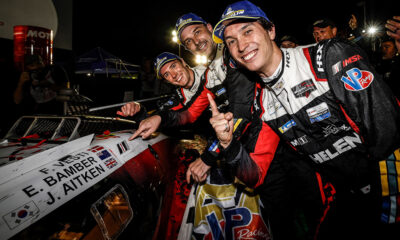
Photo: Darren Pierson/DPerceptions
The second and final day of TUDOR United SportsCar Championship testing at Daytona International Speedway ended with the DeltaWing atop the overall time sheets, as the rest of Prototype and Prototype Challenge cars were sent packing after IMSA and Continental Tire’s joint decision to suspend prototype testing on the grounds of safety.
A number of tire-related incidents on Tuesday, including accidents for both Richard Westbrook and Joao Barbosa that resulted in their Corvette DPs becoming airborne, has prompted teams to question what can and will be done to rectify the issues, with only 67 days until the season-opening Rolex 24 at Daytona.
“This summarizes how the last three months have gone. It’s been painful,” said Starworks Motorsport team owner Peter Baron, who turned up this week with both a DP and a PC car.
With a yet-to-be-confirmed set of Prototype regulations, and the proposed DP aerodynamic updates possibly contributing to the cars taking flight, further changes could still be on the horizon as IMSA works to solve one of two issues at hand.
“We got on the phone last night with all of the relevant aerodynamicists that have worked on the project from every aspect, from Ford to Pratt & Miller to Multimatic. We’ve got everybody on the horn and we’re looking through it and seeing where we’re going,” IMSA’s Scot Elkins told Sportscar365.
“It is an unintended consequence but I think anything that goes backwards at 180 mph has the potential for doing that. We don’t necessarily know that the diffuser is what caused that but we’re going through and doing some studies on that.”
Both cars that suffered airborne accidents were Coyote-chassied Corvettes, utilizing IMSA’s new diffuser, tunnels and dual element rear wing package that hadn’t been wind tunnel tested on a full-scale car until this Monday. The parts made their on-track debut last weekend at Sebring without issues.
However, it wasn’t the first time a DP car had a high-flying shunt at Daytona. Tracy Krohn had a near-identical accident in a private test in 2009, when his Pirelli-shod Lola-Ford suffered a right-rear tire failure in the tri-oval, sending the Texan’s Gen-2 DP backwards and up into the air, and almost clearing the catch fence.
“When you look at the back of a DP car, it’s hard not to see how that’s going to fly,” Baron said. “Something has to be done to that. Tires are one issue but they need to work on [the car]. The speed’s fast enough [at Daytona], if they got rid of the diffuser, that’s fine and would save a lot of heartache there.”
And while some have been quick to point the blame to Continental, it’s understood some teams, both in Prototype and Prototype Challenge, had been running below the suggested tire pressure and camber settings that the manufacturer had laid out at the start of the test, which could have also been a contributing factor.
“If we were here alone… my solution would have been to go up on [tire] pressure a bunch,” said Marsh Racing team owner Ted Marsh. “It wouldn’t have scared me. I’m used to running high banked ovals. You never come to a high banked oval to run your road race/flat track pressures. You don’t do that.”
Marsh said his 2014-spec Corvette DP ran with tire pressures 5 pounds over Continental’s minimum recommendation and had no issues during its abbreviated test on Tuesday.
While no P2 or PC cars suffered tire failures, they were also parked Wednesday on a precautionary basis, as the ALMS-based machinery also utilized the same Continental P1000 tire construction that had been used on the DPs.
“We didn’t experience anything, which is fortunate for us, I would say,” said Extreme Speed Motorsports director of operations Robin Hill. “We had some different things to try [today] to get us a little bit quicker around the track. That’s all gone by the wayside. It is what it is. It’s a safety issue, so we rather be safe.”
ESM’s HPD ARX-03b managed to turn a best time of 1:43.580 on Tuesday, which was nearly four seconds off the pace from the quickest DP. The team was set to evaluate different air restrictors in order to provide IMSA with more data in its Balance of Performance process.
“I think we need weight out of the car and need to be more competitive,” Hill said. “Right now, we’re nowhere close. PCs and GTs were passing us. It’s not like you can say it’s slow in the straightaway but fast on the infield. It’s slow in every sector. I think the powers-to-be have to think about how to bring us closer together.”
Elkins was unable to give a specific timeframe on any possible changes that could be in the works. A number of DP teams have private testing scheduled at Daytona next month, in advance of the Roar Before the Rolex 24 on Jan. 3-5, 2014.






















